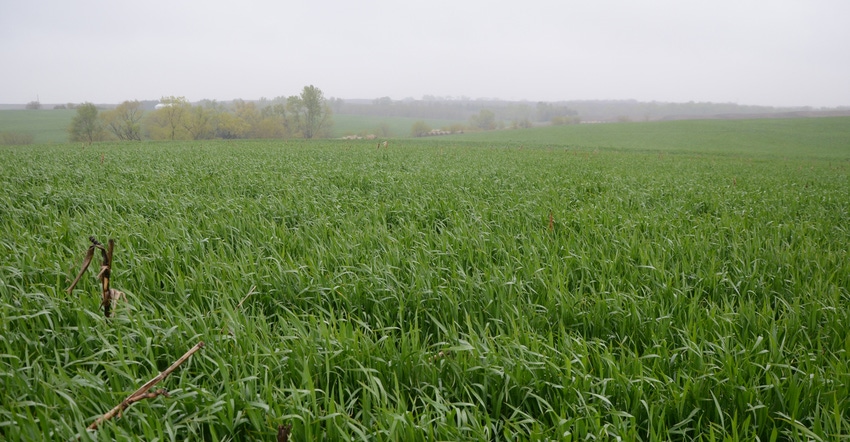September 7, 2018

Especially in dry years, discussions around cover crops and water use and retention can get heated. Do cover crops prevent more water from being lost to evaporation than they use through transpiration?
For a state like Nebraska, where average annual rainfall ranges from over 30 inches in the southeast to around 14 in the far west, the answer depends on the location as well as the year.
Cover crops have become a hot-ticket item over the last 10 years, but keeping the soil covered with residue to prevent evaporative losses goes back years in Nebraska and other Great Plains states, notes Paul Jasa, Nebraska Extension engineer.
"When the old-timers used to plow wheat stubble after harvest, they always plowed it the week they harvested. If they'd have waited a month, the soil would've been dry, hard and not easy to plow. The reason it's easy to plow right after harvest is because all the moisture captured by wheat stubble is right at the soil surface," Jasa says. "After the crop is removed, it's exposed to wind and evaporation. That's why it plowed hard later."
Those same benefits apply to cover crops, and Jasa notes it's important to plant them right after harvest to use the water that is otherwise lost. Jasa has seen firsthand the benefits of cover crops on yield to the following crop because of additional water-holding capacity on cover crop plots at Rogers Memorial Farm east of Lincoln.
"A couple years ago, the average APH [actual production history] for dryland corn in Lancaster County was 119 bushels per acre. Irrigated corn was 171. Our actual dryland APH was 186," Jasa says. "If you look at crop water response for corn, it's about 12 bushels per acre inch. We had a 60-bushel advantage over other drylanders. That means we saved 5 inches of water. That 5 inches is because we've reduced evaporative losses, and we've got more water soaking in. You might have a 5-inch rainfall that can infiltrate now that couldn't before."
How effective cover crops are at retaining water depends on the year and the location. In the last three years at three irrigated locations in Nebraska, research on cover crops and their impact on water was conducted by Roger Elmore, Nebraska Extension cropping systems agronomist, and Katja Koehler-Cole, postdoctoral research associate in the University of Nebraska-Lincoln's Department of Agronomy.
The research involves planting cereal rye from mid-September to early November, and terminating it two weeks before planting corn or soybeans the following spring.
Most years, notes Koehler-Cole, there isn't much of a difference in the impact on soil moisture levels between cover crops and no covers.
Koehler-Cole says the soil water measurements, taken with neutron probes at termination time in spring and again at midseason, aren't continuous, and there may have been other changes in soil water content that went unnoticed. Also, there wasn't much growth in the cereal rye — about 1,000 pounds of biomass per acre.
"We didn't directly measure water use, but a rough number for Iowa is about an inch of water used for about a ton of dry matter. It's probably similar for Nebraska," Koehler-Cole says.
However, there was a yield difference in a separate study and location. "One year at a nonirrigated site near Concord, we had a big yield boost after a really productive rye cover crop," Koehler-Cole says. "I think that was due to having a lot of rye residue at the right time that prevented soil evaporation early in the summer. It can happen, but it's all about timing and the location."
However, in drier environments, it's still important to have something to keep the soil covered.
Bob Klein, Nebraska Extension cropping systems specialist at the West Central Research and Extension Center at North Platte, says having this wheat stubble on the ground helps break up rain droplets to prevent them from crusting the soil and running off.
"We tell growers to harvest wheat with a stripper header, so we save that straw instead of running it through the combine. Anything you run through the combine becomes fragile residue and breaks down fast," Klein says. "With a stripper header, we'll have 3- to 4-foot-tall wheat stubble. A lot of times when modern combines are used with a grain platform, you'll end up with 6 to 10 inches of stubble height. That stripper header makes a big difference."
And that stubble height makes a difference in preventing evaporative losses by reflecting light and heat, protecting moisture from wind, trapping snow, minimizing the impact of rainfall on bare soil, improving infiltration, and preventing undesirable water use from encroaching weeds.
USDA Agricultural Research Service data from Colorado suggests 18 inches of stubble height compared to 10 inches can mean anywhere from 1 to 3 inches more water in the soil. A single inch of water is worth 6 or 7 bushels of wheat, and as much as 15 bushels of corn.
"In the drought of 2012, in the rural Big Springs area, we still had 70-bushel corn behind a 70-plus-bushel wheat crop harvested with a stripper header the year before," Klein says. "That residue is really the key to the game."
You May Also Like




